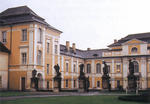 Duchcov Castle
Duchcov Castle
The best of Duchcov Castle:
Originally a Renaissance
building, later reconstructed in the Baroque, definitely modificated
in 19th cent. and acquired its present classical sober appearance.
Three-wings building encloses the court of honour and the right wing
is connected with the "Castle Church". Since 15th cent. it was a seat
of Wallenstein family. Duchcov
enjoys the interest of bath visitors from near-by Teplice. Duchcov
Castle attracts many visitors owing to its beautiful garden with a
famous alley. Almost famous Czech baroque artists - V.V.Reiner, M.B.Braun,
F.M.Brokof decorated the castle and contiguous church. Moreover it's
worth to see the interior of the castle with a exhibition of historical
furniture belonging to the Prague Museum of Applied Arts and exposition
of Czech Baroque oil paintings and plastics from the Collections of
The National Gallery and collection of pictures of Wallenstein gallery.
Also the name of Giacomo Casanova who lived and died here, attracts
attention of many visitors.
History and architecture
Original Gothic fortress was to the order of Vaclav Popel of Lobkowicz
reconstructed by Vlach Filip after Ulrica Aostalli`s plans. In 1642
Duchcov fell into the possession of Wallensteins. Jan Bedrich of Wallenstein
invited French architect
Jean Baptist Mathey who carried out
in 1675-1685 architectonic modifications. J.B.Mathey also planned (Archbishop's
palace in Prague, Troja Chateau, etc..)The building in Duchcov became
a significant turning point in Czech history of castle architecture
and in spite of later modifications, basic three -wing structure with
corps-de-logis was kept until today. The building work was continued
by Marcantonio Canevalle and then by
Frantisek Maxmilian Kanka.
He built up a long wing with stable and readapted the garden after a
plan by Jan Ferdinand Schor. In the garden was laid out a church of
the Assumption of Our Lady and famous feudal hospital. The garden in
French style contained terraces, balustrades, and system of fountains
and pools.
F.M.Kanka co-operated during his life with Vaclav Vavrinec Reiner
and Matyas Bernard Braun. Both decorated Duchcov.Vaclav Vavrinec
Reiner painted the ceiling in the main hall representing Jindrich
of Wallenstein and his twenty-four sons in the presence of King Premysl
Otacar II. The main hall is until today the most beautiful room in
the castle. It contains also ancestral portraits of Wallenstein family,
someone of them by V.V.Reiner. Matyas Bernard Braun decorated
the exterior of the castle. His four allegorical sculptures of Minerva,
Mars and two Hercules are situated on four pillars that separate the
court of honour from the exterior courtyard. Other sculptures from
the studio of M.B.Braun are to be seen in the niches of the staircase
- Boreas and Oresthea and also in the park. Jan Josef of Wallenstein
continued collecting work of famous painters of 17th cent. (Vemeer,
van Dyck, Canalett..) In 1741 many of these rich pictures was sold
to Dresden. In 19th cent. the gallery contained 400 pictures and 7000
engraving. Some of these works have been preserved up to the present
as Adonis and Venus of Bartolomej Spranger, Portrait of Boy in red
by Lucas Cranach and Karl van Mandera`s Triumph of Love. Unfortunately
a beautiful appearance of the garden and of a feudal hospital has
had to give away to the ever more extensive coal mining operations,
but the Reiner`s famous frescos (1728) which adorned the hospital
chapel have been removed. In this chapel Ferdinand Maxmilian Brokof
(other of the best Czech baroque artist) created in 1725 beautiful
stone and stucco figures of Calvary which has been also removed and
are to be seen in Castle Church.
Between 1814 and 1818 Duchcov gained its present appearance. At
that time the castle belonged to Frantisek Adam - Jan Josef of Wallenstein`s
brother. The interior and the exterior of Duchcov were subjected to
a classical reconstruction and the garden was reconstructed in English
style and in 1816 a famous alley was laid out there. In 1901 Jiri
Jan of Wallenstein - the last of duchcov line of the family died.
In 1922 Duchcov was bought by municipality. In 1835 important political
negotiations took place within its walls involving the King of Prussia
and both Russian and Austrian emperors. Duchcov enjoyed the interest
of Wolfgang Goethe, Friedrich Schiller, Ludwig van Beethoven, Frederic
Chopin, Josef Haydn and Wolfgang Amadeus Mozart who also visited and
worked in Duchcov Castle. Very famous Giacomo Casanova lived,
died and is buried here. In the later 18th cent. he worked as a librarian
of Count Emanuel of Wallenstein. Nowadays Duchcov offers a visit of
his rooms and in 1998 prepares many cultural actions as a reminder
of Casanova's death.
Useful information
| Address
| Namesti republiky 9; 419 01 Duchcov
tel. 0417/835 301; fax. 0417/835 170
|
| Open
| April, October 9 a.m. - 4 p.m. (every day except Monday)
May - September 9 a.m. - 6 p.m. (every day except Monday)
Last excursion one hour before closing time
|
 Guide
Guide 

